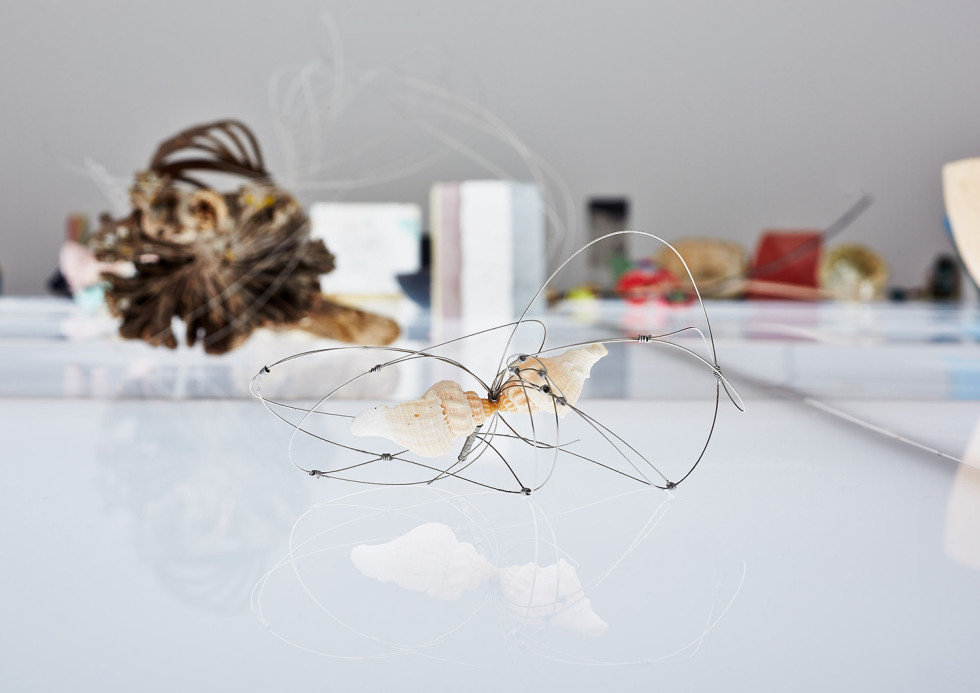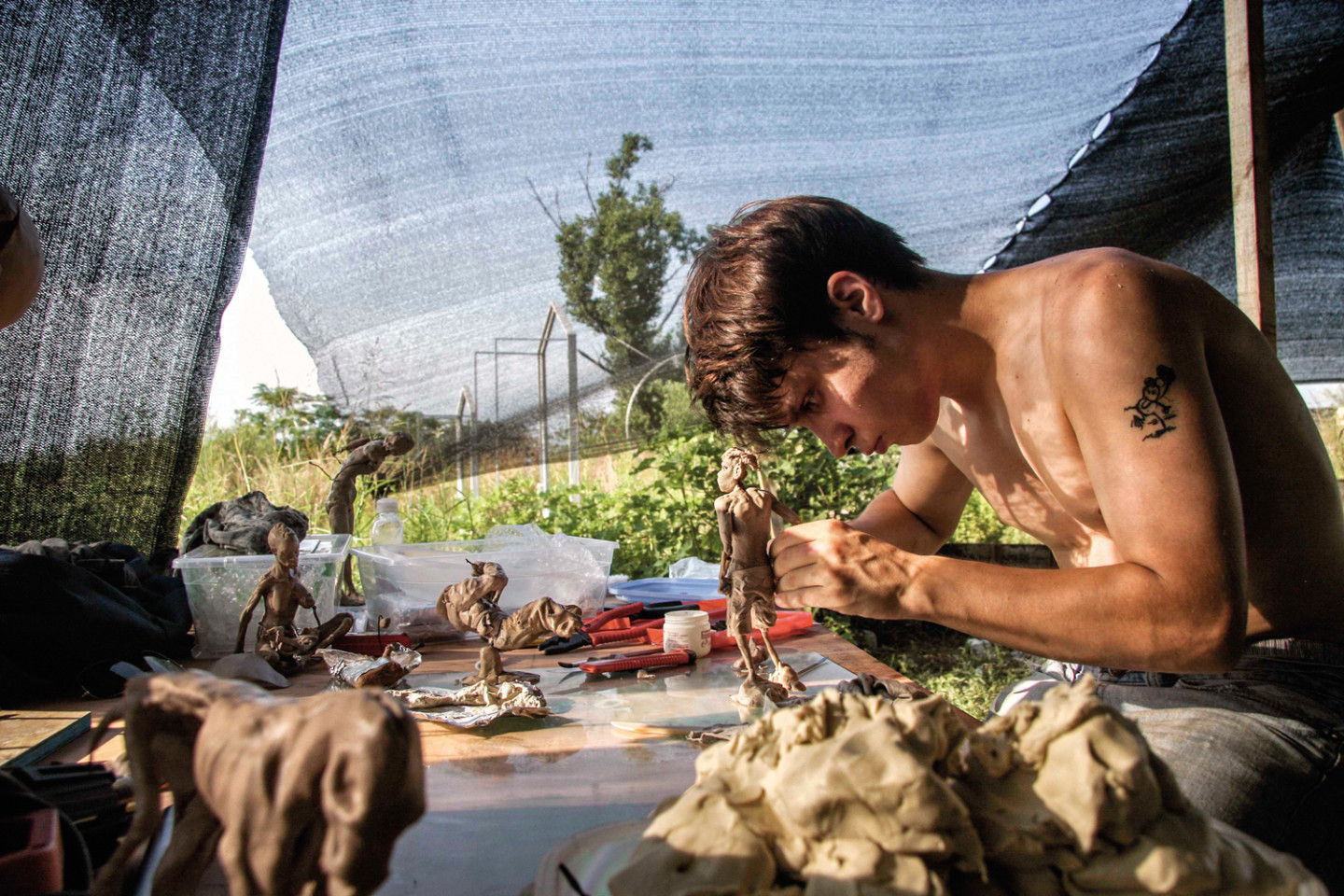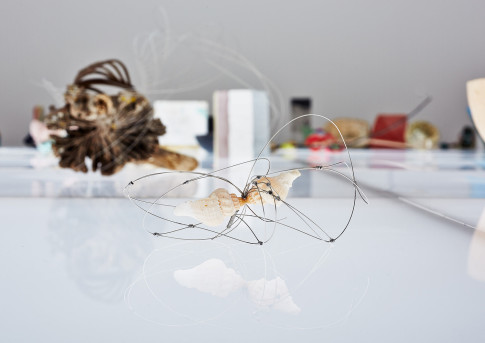
Adrián Villar Rojas, Installation view Fantasma, Moderna Museet, 2015 © Adrián Villar Rojas. Courtesy the artist; kurimanzutto, Mexico City; Marian Goodman Gallery, London, Paris and New York. Photo: Jörg Baumann
Fantasma
His starting point is often a story taken to its utmost limit – a fiction set on the verge of something absolute that involves a series of conditions or rules to relate to.
Adrián Villar Rojas is best known for his site-specific, often monumental works in unfired clay and other organic materials that are allowed to change or disintegrate. He is based in Rosario, Argentina, but works and travels incessantly with his collaborators. Following an initial phase of research and concept, the team is tailored for the production at hand, an endeavour that may require months of on-site work. Several of the team members are artists; others are craftsmen – fuelling the developing project with their own creativity.

farm in Rosario modelling a series of miniature sculptures
for the exhibition "The work of the ocean (De 11 Lijnen,
Brussels)", 2013.© Adrián Villar Rojas. Photo: Mario Caporali
Converting his nomadic studio into a theatre stage or film set, Villar Rojas has compared his role to that of an artistic director or leader of an ensemble: carefully casting and writing the role of his crew into the script of the work, while questioning and challenging notions of ownership and authorship. The time many artists invest in their studios, or authors in their writing, he devotes to working with his team. What then takes place is the result of this investment – a reading in materials that are often ephemeral, or sometimes do not even take physical form. All is part of the work – from concept and experiment to production and final deterioration.
In Fantasma, Villar Rojas explores how a traditional museum exhibition – where objects are categorised and preserved for posterity – would function for his practice. The exhibition title (“ghost” in Spanish) covers several aspects of absence and memory. At the core is an exploration of the memory surrounding and shaping objects, where each work can be understood as a recording device. The exhibition also embraces another obsession, that of the artist’s own disappearance: What will be left of my work to show when I no longer exist? – not least in the void that remains after artistic projects that no longer exist in the material world have been reduced to reminiscences and documentation.
In the exhibition spaces, the surreal dimensions and artificial light of the elevated museum environment seem to suggest a mausoleum. The exhibition can be viewed as a comprehensive installation, where texts by the artist’s brother, playwright and director Sebastián Villar Rojas, accompany us with anecdotes, associations and facts as we move from gallery to gallery. The exhibition opens with two monuments – Michelangelo’s David in Florence and the recently demolished Columbus monument in Buenos Aires – juxtaposed in a negative space shaped by sealed chambers, secret walls and blind alleys, spatial and ideological. A cake from an early installation by Villar Rojas is a personal monument of a different kind, one of the few key works salvaged in the artist’s oeuvre, yet inevitably in a state of decline. Contaminating the soundscape of the exhibition is a cinematic installation, where the camera moves silently between interiors and landscapes, seemingly interchangeable settings, like levels in a computer game. A traveller’s observations but also a questioning as to who has access to these places, and who owns and determines the content being produced here?
The largest gallery is dominated by a sculpture, a podium that appears to challenge any notion of man as the measure of all. As onlookers, we are involved in a choreography around a collection of rare objects in transformation that have become almost impossible to classify as flora, fauna or mineral. Villar Rojas’s works undertake an elliptical time voyage that undoes the notion of the finished work. In materials such as fruit, plaster, pigment, electronics and moss, his objects embark on a movement towards dissolution the moment they are created, but can also be seen as something entirely new in every phase. Another kind of alchemical process is also present here, transforming the simple materials in the museum’s galleries into precious objects.

The installation in the final gallery, with its paintings set into the walls like murals or stained glass, becomes a sign beyond language. Here, the exhibition comes to a head in a vanitas on the ideology of museums and collections, yet a monument to an artist’s self-consuming practice.
Villar Rojas’s process filters impressions from a wide spectrum: art, science and technology. We can discern influences from a writer such as Jorge Luis Borges, a philosopher like Timothy Morton, film-makers such as Stanley Kubrick and Charlie Kaufman. But Lucio Fontana is also a reference – the Argentine-born artist who in 1946 contributed to the seminal Manifesto blanco, which radically proposed art for the space age. A starting point for an all-encompassing arte spaziale that envelops both time and space, nature and industry, and seeks to operate alongside the art-historic and market-related notions of the iconic masterpiece. Art as a gesture, rather than a static object, extending into a fourth, temporal dimension. A fascination for time as a material – or rather, as the catalyst to which all matter reacts – is essential to Villar Rojas’s entire approach.
Adrián Villar Rojas compares his practice to a virus that lives in and off the art world. Although rarely overtly political, his works are ideologically charged in how they are produced and positioned outside any economy. In these works, a radical ending is inscribed in each work, as in a drama or in life itself.
Lena Essling, Curator


